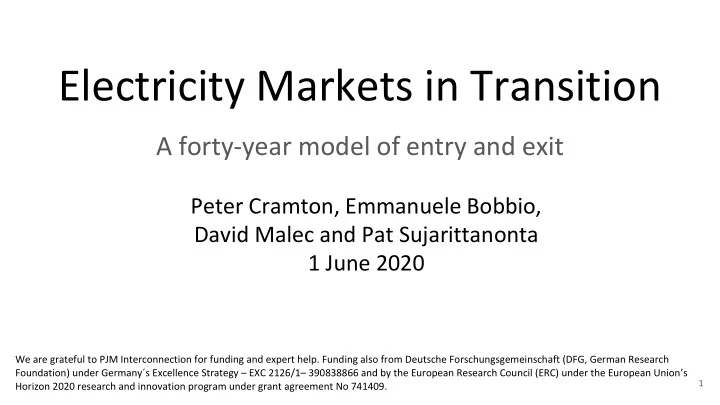

Electricity Markets in Transition A forty-year model of entry and exit Peter Cramton, Emmanuele Bobbio, David Malec and Pat Sujarittanonta 1 June 2020 We are grateful to PJM Interconnection for funding and expert help. Funding also from Deutsche Forschungsge meinschaft (DFG, German Research Foundation) under Germany´s Excellence Strategy – EXC 2126/1– 390838866 and by the European Research Council (ERC) under the European Union’s 1 Horizon 2020 research and innovation program under grant agreement No 741409.
2
3
4
5
6
7
Electricity market design matters 8
Texas (ERCOT): $10/month plus wholesale price (3 cents/kWh) 9
California ISO: $16/month + more than 25 cents/kWh 10
Rich free-ride on poor thanks to net metering 11
12
Climate policy matters 13
14
15
16
Carbon pricing 17
How does transition depend on market rules and policy? Long run model Not steady state Must model energy market 18
The model Entry and exit based on forward looking, rational investors Each resource has anticipated cash flows for life of plant Capacity payments (if any) Energy and reserve revenues Less fixed and variable costs Most uneconomic resources exit; most economic resources enter Approximate equilibrium found where expectations are consistent 19
Must model energy market Energy revenues depend critically on resource structure Some resources are substitutes, some are complements Even with a fixed resource structure, energy rents are hard to compute Day-ahead market is a large mixed-integer program (MIP) Determines schedule and prices (financially binding) Intraday is done every hour to reschedule (for planning) Real time is economic dispatch every 5 minutes Many days in the year 20
Entry and exit is a long run decision Life of plant is 20 to 40 years or more State space is infinite dimensional Resource structure Market rules Climate policy Extent of price responsive demand Evolution of technologies 21
Simplifying assumptions Transmission constraints do not bind Bids and offers for energy and capacity are competitive Exception: hockey-stick offers when resource is near its upper limit 22
Scarcity pricing Case 1: Near shortage, reserve price increases rapidly to value of lost load (e.g., $9000; this is an Operating Reserve Demand Curve) Case 2: Reserve price jumps to VOLL when violate reserve requirement 23
Climate policy Investors anticipate carbon price path over life of plant 24
Technology Combined cycle becomes more flexible over time Next-gen nuclear has lower entry, fixed, and variable costs (after 2030) Renewables have lower entry and fixed costs and improved efficiency over time Storage has lower entry and fixed costs 25
Market rules Reference case has efficient market rules Inefficient rules are also considered 26
Energy Market Proxy Capacity Market Energy Market Model Model Load Forecast Model 27
Load Forecast Model Forecast net load hourly Load (traditional) minus production from non-responsive resources: Solar Onshore wind Offshore wind Run of river hydro Actual net load hourly Actual net load in five-minute intervals 28
Energy Market Model For a fixed resource structure , get net load forecast Run energy market for 365 days Energy and reserves co-optimized both day ahead and real time Day ahead unit commitment for scheduling and day-ahead pricing Intraday MIP to adjust schedule Real time economic dispatch for real time prices and quantities Settlement Key output: Energy rents (energy + reserves profits) for each type of resource (a point in our “truth table”) 29
Energy Market Model For a fixed resource structure , get net load forecast Run energy market for 365 days Energy and reserves co-optimized both day ahead and real time Day ahead unit commitment for scheduling and day-ahead pricing Intraday MIP to adjust schedule Real time economic dispatch for real time prices and quantities Settlement Key output: Energy rents (energy + reserves profits) for each type of resource (a point in our “truth table”) 30
Storage Batteries are fundamentally different Marginal cost (benefit) is opportunity cost (benefit) Opportunity cost depends on price expectations and capabilities Approach Day ahead: directly model battery characteristics and schedule optimally Real time: optimally dispatch based on linear program 31
Price responsive demand Portion of load is traditional Portion of load is price responsive Constant elasticity ( a 1% increase in price, decreases quantity by .05%) Demand curve for price responsive demand explicitly modeled in MIPs and LPs 32
Energy Market Proxy Reduce list of units to almost sufficient statistics to describe resource structure From truth table (actual energy market rents), econometrically estimate Energy rents for each resource type Energy rents for each unit Periodically call energy market model to compute exact energy rents Update parameter estimates using expanded truth table 33
Capacity Market Model Simulate for years 2019 to 2113 Form expectations up to 50 years ahead Run capacity market (if any) Find capacity price where supply and demand intersect Alternate exit (most uneconomic) and entry (most economic) Run energy market for current delivery year (to expand truth table on equil path) Update expectations (continue until expectations are consistent) 34
Resource types (14) Coal, CT, CC Nuclear, Next-Gen Nuclear (2030 on) Hydro, Run-of-River Hydro Onshore Wind, Offshore Wind Solar Battery Storage (1, 2, 4, 8 hour duration) 35
Other calibration factors Initial list of units and characteristics Operating costs, variable costs, fixed costs, fuel prices Efficiency of renewables Initial capacity values (updated with exponential smoothing based on performance) Financial parameters (discount rate) Demand parameters 36
Scenarios Market rules (capacity market, energy-only market, other) Fuel prices (low, medium, high) Carbon price (none, low-end 2 ℃ , low-end 1.5 ℃ , twice that) Price response demand (none, annual growth 1 percentage point, twice that) 37
Results... 38
Detailed evidence of impact of market rules and policies on: Market efficiency Cost to load Profits for suppliers Reliability … 39
40
Recommend
More recommend